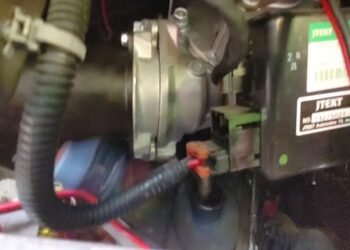If you own a Toyota Tundra or are thinking about getting one, you might have heard about the flex fuel problems that some drivers face. These issues can affect your truck’s performance, reliability, and even your wallet.
You deserve to know what to watch out for and how to handle common flex fuel challenges before they slow you down. We’ll break down the most frequent Toyota Tundra flex fuel problems, explain why they happen, and share practical tips to keep your truck running smoothly.
Keep reading to protect your investment and avoid surprises on the road.

Credit: www.ebay.com
Flex Fuel System Basics
The flex fuel system allows the Toyota Tundra to run on different fuel types. It can use gasoline or a blend of gasoline and ethanol. This system helps reduce emissions and can save money at the pump. Understanding how it works is important for spotting and fixing problems.
The flex fuel system has parts that work together to detect fuel type and adjust the engine. This keeps the truck running smoothly and efficiently. Knowing these parts helps owners recognize issues early.
How Flex Fuel Works
The flex fuel system uses sensors to detect ethanol levels in the fuel. The engine control unit (ECU) then adjusts fuel injection and timing. This keeps the engine running well on different fuel blends. Ethanol burns differently than gasoline, so these adjustments matter. The system also ensures emissions stay low no matter the fuel.
Common Flex Fuel Components
Key parts include the ethanol sensor, fuel pump, and ECU. The ethanol sensor measures the fuel blend continuously. The fuel pump delivers the correct amount of fuel based on sensor data. The ECU processes the sensor info and controls engine settings. Problems with any part can cause rough starts or poor performance. Regular checks of these components help maintain the system’s health.
Frequent Flex Fuel Problems
The Toyota Tundra Flex Fuel system aims to offer versatility by allowing the use of ethanol-blended fuels. Despite this benefit, some owners report engine performance issues. These problems affect how the truck runs and may cause frustration. Understanding these issues helps in managing expectations and maintenance.
Reduced Power Output
Many drivers notice the Tundra loses power when using flex fuel. The engine does not respond as strongly as with regular gasoline. This reduction in power can affect towing and acceleration. The problem may stem from the engine’s difficulty adjusting to ethanol blends. This leads to weaker combustion and lower overall performance.
Fuel Economy Drops
Fuel economy often declines with flex fuel use in the Tundra. Ethanol contains less energy than pure gasoline, so the truck consumes more fuel. This results in more frequent stops at the gas station. The drop in miles per gallon can be significant. Owners should expect lower efficiency when using higher ethanol content fuels.
Ethanol Compatibility Challenges
The Tundra’s engine and fuel system face challenges with ethanol compatibility. Ethanol can cause corrosion in certain fuel components. Some sensors may give inaccurate readings due to ethanol’s different chemical makeup. This can trigger check engine lights and affect engine timing. These challenges require extra care and sometimes repairs to maintain engine health.
Engine Performance Issues
The Toyota Tundra Flex Fuel models sometimes face electrical and software glitches. These issues affect vehicle performance and driver experience. Problems can range from fuel pump control to the infotainment system. Understanding these glitches helps owners manage repairs better.
Fuel Pump Control Module Errors
The fuel pump control module in Flex Fuel Tundras can fail. This causes the fuel pump to work improperly or stop. Drivers may notice hard starts or stalling. The engine might run rough or lose power suddenly. These errors trigger warning lights on the dashboard. Reprogramming or replacing the module often fixes the problem. Ignoring these issues can lead to more serious engine trouble.
Infotainment System Bugs
Many Toyota Tundra owners report bugs in the infotainment system. The screen may freeze or reboot by itself. Bluetooth connections often drop or fail to pair. Audio controls can become unresponsive during use. These glitches disrupt the driving experience and cause frustration. Software updates from Toyota can resolve many of these problems. Keeping the system updated reduces the chance of bugs.
Credit: www.tundras.com
Electrical And Software Glitches
Older Toyota Tundra Flex Fuel models have shown certain issues over time. These concerns mostly affect the engine’s emission control and exhaust systems. Understanding these problems helps maintain vehicle performance and avoid costly repairs.
Secondary Air Injection Failures
The secondary air injection system helps reduce emissions during cold starts. Older Tundra models often suffer from rust damage in this system. Rust clogs valves and pumps, stopping air flow. This failure triggers the check engine light. Engine performance may drop and emissions rise.
Exhaust Manifold Leaks
Exhaust manifold leaks are common in older Flex Fuel Tundras. Cracks or gasket failures cause these leaks. Drivers may hear a grating or ticking noise from the engine area. Fuel economy can worsen due to poor exhaust flow. This issue also risks engine damage if not fixed.

Credit: www.youtube.com
Frequently Asked Questions
What Is The Most Common Problem With Toyota Tundra?
The most common problem with Toyota Tundra is engine issues caused by manufacturing defects, including debris-related failures. Owners also report infotainment glitches, wind noise, and warped brake rotors. Flex-fuel models may face fuel pump and corrosion problems, affecting performance and reliability.
What Are The Problems With Flex Fuel Engines?
Flex fuel engines may suffer reduced power due to ethanol’s lower energy content. Ethanol’s corrosiveness can cause engine rust. Moisture buildup from ethanol may lead to fuel system issues. These factors can decrease fuel economy and increase maintenance needs over time.
What Does Flex Fuel Mean On A Toyota Tundra?
Flex Fuel on a Toyota Tundra means it can run on gasoline or ethanol blends up to E85. It offers fuel flexibility but may slightly reduce power and fuel economy.
What Year To Avoid Toyota Tundra?
Avoid Toyota Tundra models from 2007-2010 due to secondary air injection failures and exhaust manifold leaks. Also, 2022 models face engine debris defects causing recalls. These years show common engine, fuel, and infotainment issues affecting reliability and performance.
What Common Flex Fuel Problems Affect Toyota Tundra?
Toyota Tundra flex fuel trucks often face rough starts and fuel pump issues.
Conclusion
Toyota Tundra Flex Fuel problems affect many drivers. Common issues include hard starts and fuel pump failures. These problems can cause frustration and added repair costs. Regular maintenance helps reduce the risk of trouble. Checking for recalls and service bulletins is wise.
Staying informed keeps your Tundra running smoothly. Knowing these challenges prepares you for better care. Keep an eye on your truck’s performance. Address problems early to avoid bigger repairs later. A well-maintained Tundra offers reliable service despite some flex fuel concerns.
















